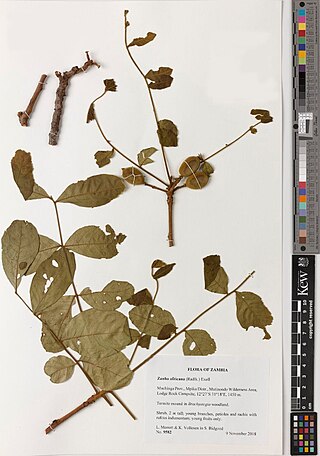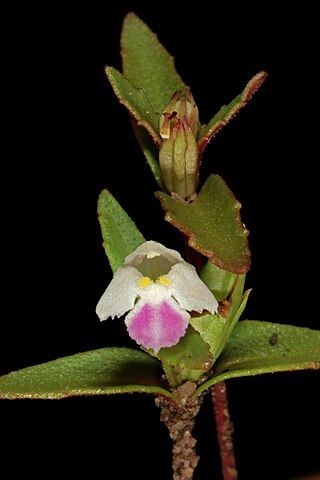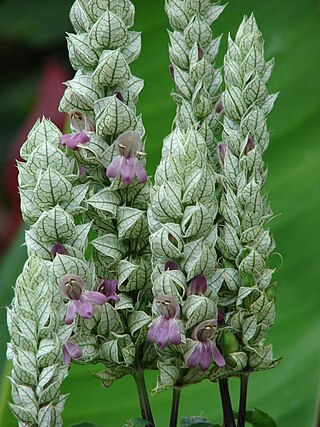
Brachystegia is a genus of tree of the subfamily Detarioideae that is native to tropical Africa.
Erythrococca is a plant genus of the family Euphorbiaceae, first described in 1849. It is native to Africa and the Arabian Peninsula.

Pseudolachnostylis is a genus of plants in the family Phyllanthaceae first described as a genus in 1899. It contains only one known species, Pseudolachnostylis maprouneifolia native to central and southern Africa. Its common name is kudu berry, though the term also applies for Cassine aethiopica. In Zimbabwe it is called mutsonzowa (Shona) or Umqobampunzi (Ndebele).

Melhania is a genus of small shrubs or herbaceous plants. Traditionally included in the family Sterculiaceae, it is included in the expanded Malvaceae in the APG and most subsequent systematics. The genus is named for Mount Melhan in Yemen.

Stylochaeton is a genus of flowering plants in the family Araceae that is native to Africa. Stylochaeton are rhizomatous with hastate leaves. Flowering in this genus is said to be quite uncommon. Stylochaeton is the sole genus in the tribe Stylochaetoneae.
Zanha golungensis is a species of plant in the family Sapindaceae that is native to Africa.

Craterispermum is a genus of flowering plants in the family Rubiaceae. It contains 16 species that occur in tropical Africa and Seychelles. It is the only genus in the tribe Craterispermeae, of which the divergence time is estimated at 34.8 million years ago.

Schrebera alata is a plant in the family Oleaceae. It grows as a tree up to 15 m (50 ft) tall. The specific epithet alata is from the Latin meaning "winged", referring to the petioles. Its habitat is forests and woodland from 1,000–1,800 m (3,000–6,000 ft) altitude. Schrebera alata is native Ethiopia, the Democratic Republic of the Congo, Uganda, Rwanda, Burundi, Kenya, Tanzania, Angola, Zambia, Zimbabwe, Malawi, Mozambique, Eswatini and South Africa.

Englerophytum is a group of trees in the family Sapotaceae described as a genus in 1914.

Zanha africana, commonly known as the velvet-fruited zanha in English and as mkalya or mkwanga in Swahili, is a species of plant in the family Sapindaceae that is native to Africa. It is used locally for timber and herbal medicine.

Tinnea (sunbells) is a genus of plants in the family Lamiaceae first described in 1867. It is native to sub-Saharan Africa. It was named in honour of the Dutch explorer Alexine Tinne.
- Tinnea aethiopicaKotschy ex Hook.f. - widespread from Mali to Somalia south to Mozambique; naturalized in Trinidad & Tobago
- Tinnea antiscorbuticaWelw. - DRC, Zambia, Angola
- Tinnea apiculataRobyns & Lebrun - eastern Africa from Rwanda to Mozambique
- Tinnea barbataVollesen - Eswatini, northern South Africa
- Tinnea barteriGürke - western Africa
- Tinnea benguellensisGürke - Angola
- Tinnea coeruleaGürke - DRC, Zambia, Angola
- Tinnea eriocalyxWelw. - DRC, Angola, Botswana, Namibia
- Tinnea galpiniiBriq. - Eswatini, Mozambique, South Africa
- Tinnea gossweileriRobyns & Lebrun - Angola
- Tinnea gracilisGürke - Tanzania to Zambia
- Tinnea mirabilis(Bullock) Vollesen - Tanzania
- Tinnea physalisE.A.Bruce - Tanzania
- Tinnea platyphyllaBriq. - DRC
- Tinnea rhodesianaS.Moore - South Africa, Namibia, Zimbabwe, Zambia, Angola, Mozambique
- Tinnea somalensisGürke ex Chiov. - Ethiopia
- Tinnea vesiculosaGürke - Tanzania, Malawi
- Tinnea vestitaBaker - Zimbabwe, Zambia, Angola, Botswana
- Tinnea zambesiacaBaker - Zimbabwe, Zambia, Malawi, Mozambique

Aeollanthus (rocksage) is a genus in the mint family, Lamiaceae. All the species are native to Africa.
Hilliardiella is a genus of flowering plants belonging to the family Asteraceae.
Lefebvrea is a genus of flowering plants belonging to the family Apiaceae.
Donella is a genus of flowering plants belonging to the family Sapotaceae.

Ritchiea is a genus of flowering plants belonging to the family Capparaceae.
Gambeya is a genus of flowering plants belonging to the family Sapotaceae.

Linderniella is a genus of flowering plants belonging to the family Linderniaceae.

Nicoteba betonica is a species of flowering plant, a shrub in the family Acanthaceae. It goes by the common name squirrel's tail and paper plume.

Drosera affinis is a carnivorous plant in the family Droseraceae. It is native to Southern Africa.













